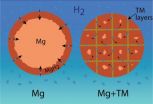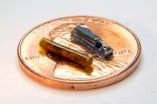(Press-News.org) With a nod to biology, scientists at the National Institute of Standards and Technology (NIST) have a new approach to the problem of safely storing hydrogen in future fuel-cell-powered cars. Their idea: molecular scale "veins" of iron permeating grains of magnesium like a network of capillaries. The iron veins may transform magnesium from a promising candidate for hydrogen storage into a real-world winner.
Hydrogen has been touted as a clean and efficient alternative to gasoline, but it has one big drawback: the lack of a safe, fast way to store it onboard a vehicle. According to NIST materials scientist Leo Bendersky, iron-veined magnesium could overcome this hurdle. The combination of lightweight magnesium laced with iron could rapidly absorb—and just as importantly, rapidly release—sufficient quantities of hydrogen so that grains made from the two metals could form the fuel tank for hydrogen-powered vehicles.
"Powder grains made of iron-doped magnesium can get saturated with hydrogen within 60 seconds," says Bendersky, "and they can do so at only 150 degrees Celsius and fairly low pressure, which are key factors for safety in commercial vehicles."
Grains of pure magnesium are reasonably effective at absorbing hydrogen gas, but only at unacceptably high temperatures and pressures can they store enough hydrogen to power a car for a few hundred kilometers—the minimum distance needed between fill-ups. A practical material would need to hold at least 6 percent of its own weight in hydrogen gas and be able to be charged safely with hydrogen in the same amount of time as required to fill a car with gasoline today.
The NIST team used a new measurement technique they devised that uses infrared light to explore what would happen if the magnesium were evaporated and mixed together with small quantities of other metals to form fine-scale mixtures. The team found that iron formed capillary-like channels within the grains, creating passageways for hydrogen transport within the metal grains that allow hydrogen to be drawn inside extremely fast. According to Bendersky, the magnesium-iron grains could hold up to 7 percent hydrogen by weight.
Bendersky adds that the measurement technique could be valuable more generally, as it can reveal details of how a material absorbs hydrogen more effectively than the more commonly employed technique of X-ray diffraction—a method that is limited to analyzing a material's averaged properties.
INFORMATION:
* Z. Tan, C. Chiu, E.J. Heilweil and L.A. Bendersky. Thermodynamics, kinetics and microstructural evolution during hydrogenation of iron-doped magnesium this films. International Journal of Hydrogen Energy, 36 (2011), pp. 9702-9713, DOI: 10.1016/j.ijhydene.2011.04.196
Iron 'Veins' Are Secret of Promising New Hydrogen Storage Material
2011-09-01
ELSE PRESS RELEASES FROM THIS DATE:
Registration Opens September 1 for 4th Annual Renton FilmFrenzy, a 50-Hour Filmmaking Competition with $1,700 in Cash Prizes; Filmmakers will Take Over Renton from Oct. 7-9
2011-09-01
It will be "lights, camera, action" in Renton from October 7-9, when aspiring, ahead of the curve filmmakers take over the city for the fourth annual Renton FilmFrenzy, a 50-hour filmmaking competition. Last year, 25 filmmaking teams competed for $1,700 in cash prizes and the coveted Curvee Awards.
"Thanks to our partnerships with SIFF, Reel Grrls, theFilmSchool, area filmmaking programs, and the Renton Arts Commission, the Renton FilmFrenzy continues to expand and has become an integral part of the growing and strong Renton arts community," said ...
Sandfly saliva provides important clues for new Leishmaniasis treatments
2011-09-01
Bethesda, MD—For millions of people who live under the constant threat of Leishmania infection, a new discovery by Brazilian scientists may lead to new breakthroughs, preventing these parasites from taking hold in the body or reducing the severity of infections once they occur. In a new report appearing in the Journal of Leukocyte Biology (http://www.jleukbio.org), scientists show that specific molecules found in the saliva of the sandfly—a small flying insect that is the vector for the parasite—make it possible for Leishmania to evade neutrophils and live within human ...
Celebrate the Seventh Annual Cobra Polo Classic Benefiting Ronald McDonald House Charities
2011-09-01
Polo is possibly the oldest sport, period. The first experience with a mallet, pony and a round object were recorded nearly two thousand years ago. Polo is the sport known to royalty around the world.
On Sunday, September 11th over twelve-hundred guests will celebrate the seventh annual Cobra Polo Classic benefiting Ronald McDonald House Charities of Spokane. "It is the most prestigious event in the Inland Northwest," reports Mike Forness, RMHC of Spokane Executive Director. Sky divers, gourmet food and wine, cigar and Dry Fly whiskey tent, safari escape women's ...
SER2011 Mexico call to action
2011-09-01
The delegates of the Society for Ecological Restoration´s 4th World Conference on Ecological Restoration (SER2011) congratulate the Parties of the Convention on Biological Diversity (CBD) for their practical and forward looking Strategic Plan 2011-2020, including Targets 14 and 15 in which the Parties have agreed that by 2020, ecosystems of particular importance to water security, human health, and sustainable livelihoods are restored, and their resilience and contribution to carbon stocks enhanced, through conservation and restoration, including the restoration of at ...
2011 AAO-HNSF new oral research daily highlights
2011-09-01
San Francisco, CA – The 2011 Annual Meeting & OTO EXPO of the American Academy of Otolaryngology – Head and Neck Surgery Foundation (AAO-HNSF), the largest meeting of ear, nose, and throat doctors in the world, will convene September 11-14, 2011, in San Francisco, CA.
Featuring more than 386 scientific research sessions, 468 posters, and several hundred instruction course hours for attendees, the annual meeting is a unique opportunity for journalists from around the world to cover breaking science and medical news. Reporters will have access to the latest research and ...
Scientists unravel the cause of rare genetic disease: Goldman-Favre Syndrome explained
2011-09-01
Bethesda, MD—A new research report published in The FASEB Journal (https://www.fasebj.org) will help ophthalmologists and scientists better understand a rare genetic disease that causes increased susceptibility to blue light, night blindness, and decreased vision called Enhanced S-Cone Syndrome or Goldman-Favre Syndrome. In the report, scientists found that the expression of genes responsible for the healthy renewal of rods and cones in the retina was reduced and that this problem originates in the photoreceptors themselves rather than in the adjacent retinal pigment epithelial ...
'Pink ribbon dollars' help fill financial gaps for breast cancer programs
2011-09-01
A new study shows that donations collected by check boxes on state income tax forms, fees from license plates and revenue from state lottery tickets have raised millions for breast cancer research and prevention programs across the country, according to researchers at Washington University in St. Louis.
"We found that revenue-generating breast cancer initiatives can be a successful strategy for states to raise funds, or 'pink ribbon dollars,' for prevention and early detection programs," says Amy A. Eyler, PhD, research associate professor at the Brown School of Social ...
Carlsbad, New Mexico, to Host National Nuclear Fuel Cycle Summit
2011-09-01
The Carlsbad Department of Development (CDOD) has announced the first annual National Nuclear Fuel Cycle Summit, taking place April 2-5, 2012. The Summit will be hosted by Carlsbad, New Mexico, and will include renowned experts from the various nuclear-related industries across the nation.
Panel discussions will provide members of the public and policymakers with valuable insights into and strategies addressing our national nuclear fuel cycle policies, our nation's growing energy needs, nuclear waste management, regulation, and funding. A lively discussion on the highly ...
Cracking cellulose: a step into the biofuels future
2011-09-01
Scientists from the University of York have played a pivotal role in a discovery which could finally unlock the full potential of waste plant matter to replace oil as a fuel source.
Professor Paul Walton and Professor Gideon Davies, of the University's Department of Chemistry, were part of an international team that has found a method to overcome the chemical intractability of cellulose, thus allowing it to be converted efficiently into bioethanol.
Working with scientists in Novozymes laboratories at Davis, California, and Bagsvaerd, Denmark, as well as researchers ...
Tiny oxygen generators boost effectiveness of anticancer treatment
2011-09-01
WEST LAFAYETTE, Ind. - Researchers have created and tested miniature devices that are implanted in tumors to generate oxygen, boosting the killing power of radiation and chemotherapy.
The technology is designed to treat solid tumors that are hypoxic at the center, meaning the core contains low oxygen levels.
"This is not good because radiation therapy needs oxygen to be effective," said Babak Ziaie, a Purdue University professor of electrical and computer engineering and biomedical engineering. "So the hypoxic areas are hard to kill. Pancreatic and cervical cancers ...


